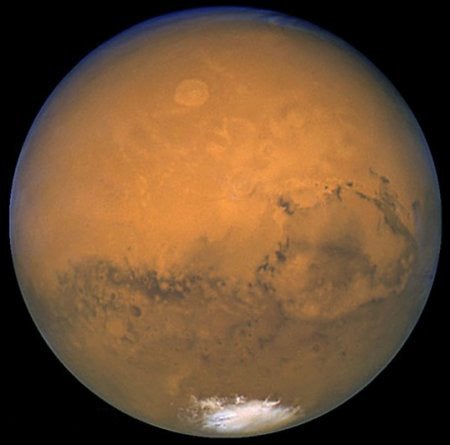An opposition occurs when a planet farther from the Sun than Earth appears opposite the Sun in our sky — it’s the best time to observe a planet.
Most of the time, Mars appears as a minute, featureless disk in all but the largest telescopes. Because of the intricacies of Mars’ orbit and the planet’s small size, opportunities for a close-up view are relatively rare and short in duration.
While the upcoming opposition, slated for the evening of November 6/7, won’t break records like the last one, Mars will be an inviting telescopic target. In fact, Mars will be much higher in the evening sky, as viewed from mid-northern latitudes, than it was during the August 2003 opposition.
Before attacking Mars with your telescope, pause for a moment to admire its naked-eye splendor. Shining majestically as a –2.3 magnitude “star” in an otherwise barren tract of night sky, Mars at opposition will be an impressive sight. Although the “Red Planet” is more of a golden yellow or orange hue, it still catches the eye and our imagination. As we gaze at this ruddy beacon, we can understand why early civilizations thought Mars was the god of war — and in more modern times an abode of hostile aliens intent on conquering Earth.
Mars is a small planet, only about twice our Moon’s diameter and many times more distant. During opposition, you’ll need 90x just to make Mars appear equal in size to the naked-eye Full Moon. You won’t see Olympus Mons or Valles Marineris. Instead, a yellow-orange disk that dances and sways to the whims of Earth’s turbulent atmosphere will greet you.
If our atmosphere is more cooperative, you’ll be allowed glimpses of grayish areas on the martian disk. You may see a small white spot on its edge. That spot is the southern polar cap.
Take your time at the eyepiece. Observing Mars is a cerebral undertaking that requires patience and quiet contemplation.
During the last opposition, I observed Mars with a 4-inch f/8 reflecting telescope. I was impressed at how much detail such a small scope revealed. Much of my success was due to using color filters.
The filters, threaded to screw into the eyepiece, didn’t magically “clean up” atmospheric turbulence. But they did enhance contrast, making elusive detail easier to see.
Two months ago, I suggested an inexpensive alternative to glass filters: the deep-dyed polyester filters sold for theatrical use by GAMProducts, Inc. I purchased a swatch book that contains 1.5-inch by 4-inch samples of the various GamColor filters. I discovered that GamColor’s GC290 (fire orange) filter is a nice alternative for the #23A, while GC888 (blue belle) performs like the #80A.
I cut out a 1-inch square of each color, and mounted them in side-by-side 1/2-inch square windows cut from a 3- by 5-inch piece of cardboard. With Mars centered in the eyepiece, I placed the cardboard between the eyepiece and my eye, alternating between red and blue.
I’m off to get my ladder out of the garage so I can do some rooftop shouting. Hear ye, hear ye, Mars is back!
Next month: More Mars musings, and we’ll get ready for December fireworks. Clear skies.











